#east midlands railway
Text
Part 12 in shipping different railway companies together, I guess this, like Part 10 isn't exactly a ship.
May I introduce you to the London Airport Express Group. They aren't a relationship or anything, just a LinkedIn group of airport workers in and around London. They work on a fast, frequent and efficient working.
The group consists of:
Heathrow Express, she is the prestigious and classy one.
Gatwick Express, he does a fast intercity service serving a much larger region out of anyone in the group.
Stansted Express, she is the dedicated in the group but still works well, though doesn't work quite as efficiently.
Other people want to join the group:
East Midlands, who doesn't operate a proper direct service.
Greater Anglia, who doesn't even try to work efficiently.
Elizabeth Line, which does work is kind of accepted as a friend of the group as she was a friend of Heathrow Express' now dead sister (Heathrow Connect).
#heathrow express#gatwick express#stansted express#east midlands railway#greater anglia#elizabeth line#heathrow connect#uk trains#tocsu
7 notes
·
View notes
Text

EMR train in Norwich, bound for Liverpool via Sheffield & Manchaster
#phoneography#mobiele telefoon fotografie#mobile phone photography#smartphoneography#smartphone fotografie#smartphone photography#travel#travel photography#reisfotografie#reizen#reisen#voyage#viajar#Norwich#EMR#East Midlands Railway#EMR regional#train#station#railway#railways#Britain#British#Greag Britain#England#journey#reis#trip#English#Greater Anglia
5 notes
·
View notes
Text
16/09/2022 - 222002 heads south through Duffield in Derbyshire on the 1400 Sheffield to St Pancras

4 notes
·
View notes
Text
Metros, autobuses y National Rail en huelga esta semana
Metros, autobuses y National Rail en huelga esta semana
Los londinenses enfrentarán nuevas interrupciones en sus viajes esta semana debido a las huelgas de decenas de miles de trabajadores en disputas por salarios, trabajos y condiciones.
Los miembros del sindicato Rail, Maritime and Transport (RMT) en Network Rail y 14 operadores de trenes organizarán dos huelgas de 48 horas el martes y el viernes, mientras que los conductores del sindicato Aslef…
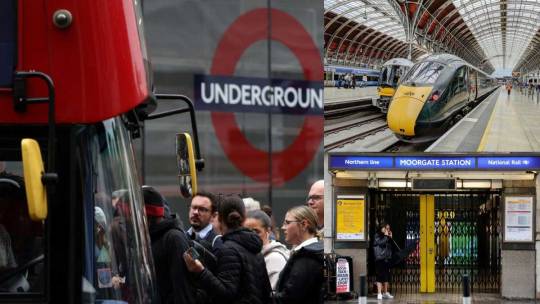
View On WordPress
#Avanti West Coast#c2c#Cross Country Trains#East Midlands Railway#fechas de las huelgas#Gatwick Express)#Great Northern#Great Western Railway#Greater Anglia#GTR (incluyendo Thameslink#huelga de tren#LNER#Northern#South Western#Southeastern#Southern#West Midlands Railway
0 notes
Text
I’m briefly in Sheffield this week, is there anything of interest in Sheffield, fellow Northerners?
0 notes
Text
Guest Blog for Creative Nottingham: I’m a newcomer: I know nothing.
“We are the Robin Hood of Europe: we will take your credit cards, your DVDs, your bank details and distribute them to our people.”
These were the welcoming words of a friendly burocrat of the Obrenovac Town Council in Serbia when I met him for the first time in 2009 as part of a trilateral cultural exchange project. I was startled and immediately searched my jacket for my credit cards, spare DVDs…

View On WordPress
#Creative Nottingham#Creative Quarter#East Midlands Railways#Liverpool to Nottingham train#robin hood#travel cliches
1 note
·
View note
Text
Happy Mallard Day!
Most people in my country will be celebrating tomorrow, July 4th. I’m a bit unusual for an American in that I’m always more excited for July 3rd, because a remarkable feat of engineering history happened that day in 1938 (in multiple senses of the word). Today I’m going to tell the story of a locomotive named for a duck.
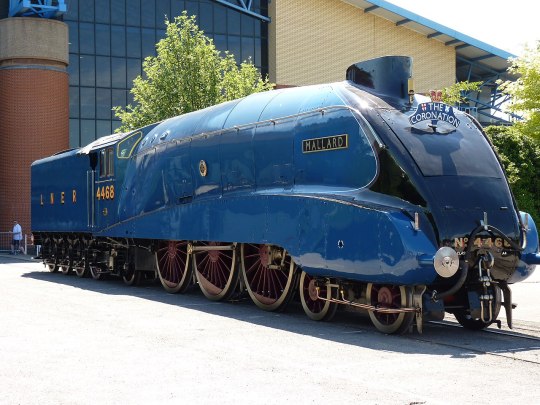
(Image: 4468 Mallard, a streamlined 4-6-2 Pacific locomotive, sitting pretty in York, England, United Kingdom. She is painted bright blue with red wheel spokes.)
The story begins well before July 3rd, 1938, of course - mechanical engineer Sir Nigel Gresley was well established in his position as the CME of the London and North Eastern Railway by that date. In 1923, his most famous creation, a 4-6-2 Pacific A1 numbered 4472, took to the rails for the first time. Originally numbered 1472, within a year of running between London to Edinburgh she received her more familiar 4472 after the LNER finally settled on a company-wide numbering scheme - and the name she’d be best known under, Flying Scotsman. She became the company’s flagship locomotive and solidified Gresley’s ability to design Pacifics in the mind of the public.
Her most important contribution to what I’m about to get into the meat of here, though, occurred on November 30th, 1934. On that date, pulling a light testing train behind her, Flying Scotsman hit 100 mph, becoming the first locomotive to hit that speed whilst being officially measured. Other locomotives may have reached 100 mph before, most notably GWR 3700 City of Truro and NYC 999, but this was the first time the speed was officially recorded, and so Scotsman got her name into the record books.
Dating back to the 19th century, railroads in Great Britain competed against each other in what was known as the Race to the North, in which they actively attempted to outdo each other and get passengers from the south, usually London, up to various destinations in Scotland. Nobody ever actually said they were racing, of course, but in retrospect it was pretty obvious what was going on as the railroads introduced faster and faster services. By the 1930s, the railroads had been consolidated into four companies - the Big Four (the Great Western, the Southern, the London, Midland and Scottish, and the heroes of this story, the London and North Eastern). The LMS controlled the West Coast Main Line, and the LNER controlled the East Coast Main Line. (This is important.) In 1927, the LNER started running the named train Flying Scotsman non-stop from London to Edinburgh, utilizing corridor tenders to perform crew changes at speed without stopping. Not to be outdone, the LMS beat them to the punch, running non-stop services between London and Glasgow and London and Edinburgh on their own, and it was officially on. Although speeds were still within a reasonable range at this point, both railroads knew they needed to go faster, and Sir Nigel Gresley looked to Germany.
In Germany, a new streamlined service called the Flying Hamburger had been introduced. This was a diesel train set that ran between Hamburg and Berlin at remarkably high speeds - it had an average speed of 77 mph and could hit around 99-100 mph at its maximum. For regular service, this was impressive, and Gresley wondered if the same could be done using steam power. He knew streamlining was the key, but the LNER knew that the diesels in Germany didn’t have the same passenger capacity as their steam locomotives could pull in carriages, so he needed to get creative. He looked to Bugatti for inspiration; their racecars, in their resplendent blue, were but one thing the car company was working on - they were making streamlined railcars, as well. Gresley took note of their designs, and his new locomotives would eventually pay homage by being colored Bugatti blue.
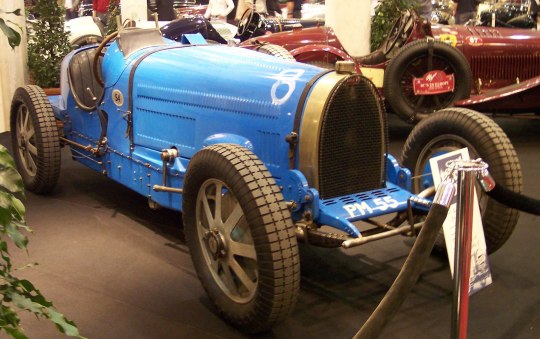
(Image: a Bugatti Type 54 racecar, painted in a vivid blue.)
By the time Flying Scotsman hit 100 mph in 1934 and another Gresley Pacific locomotive, A3 2750 Papyrus, managed to hit a whopping 108 mph without streamlining, the LNER knew that Gresley was capable of the task, and they allowed him to design a streamlined locomotive. Gresley set to work making improvements to his A3 design, and the first four A4s were born.

(Image: an unidentified A4 Pacific locomotive.)
The A4s were fast, hitting 112 mph on the inaugural run of the Silver Jubilee service between London and Newcastle in 1935. Gresley, of course, was not satisfied - he knew he could still improve his design, and at any rate, his competition over at the LMS was going to be trying to catch him. He went back to the drawing board to make the A4s even better.
As this was going on, the LMS was indeed playing catchup, and they introduced their beautiful Coronation class locomotives, designed to pull the Coronation Scot starting in 1937. The first several of them were streamlined in gorgeous, bright casings, and they caused a stir, taking the British speed record back at 114 mph in an attempt by 6220 Coronation that ended with a sudden braking and a whole lot of kitchenware being flung every which way in the dining car. Engineer/driver T.J. Clark and fireman C. Lewis kept her under control, but the passengers were not amused, and speed records were shelved for the time being...until, once again, Germany entered the fray.
Back in 1936, a German locomotive, the DRG Class 05, set a land speed record for steam, hitting 124.5 mph. Gresley was aware of this and had it in the back of his mind as he improved his A4s. He experimented with giving some of them a Kylchap exhaust system, an innovation developed by French locomotive designer André Chapelon after the work of Finnish engineer Kyösti Kylälä. Chapelon’s work went woefully under-acknowledged, but Gresley paid attention and appreciated his work, and it would pay off. Wind tunnel tests proved a bit frustrating at first until a fortuitous accidental thumbprint helped to move the smoke up and over the locomotive instead of in the crew’s faces, and the stage was set.
4468 Mallard rolled off the line at Doncaster Works on March 3rd, 1938, her name derived from Gresley’s love of breeding waterfowl. Indeed, many of her sibling locomotives were also named for birds, like 4464 Bittern, 4467 Wild Swan, 4902 Seagull, and 4903 Peregrine, but the duck was about to steal the show. Mallard spent the next few months getting used to working and being broken in so she wasn’t brand new, and on the day she turned four months old, it was time to make history.
Mallard’s driver that day was a 61-year-old grandfather named Joe Duddington. As a locomotive engineer, he was experienced and knew how to take calculated risks, and so he’d been assigned to pilot her. With him on the footplate was fireman Tommy Bray and his massive tattooed arms, ready to keep Mallard fed as they drove into the history books. They were performing a “brake test” that day, or so the LNER told most people, passengers included, but Joe and Tommy knew what was actually going on. In the cab with them was an LNER official, Inspector Jenkins, and attached to the train behind the tender was a dynamometer car, there to record Mallard’s speed throughout her run. Since this was an alleged “brake test” the dynamometer car didn’t raise any eyebrows right away. Gresley himself unfortunately wasn’t in the best health that day and was unable to be present himself, but there were enough LNER officials on hand to see to it that everything ran smoothly. Mallard was fitted with a stink bomb of sorts of aniseed in case the big end bearing for the middle of her three cylinders overheated, as the A4s had previously had difficulty with this, and she set out heading northwards. The return trip was where everything was going to get serious.
Upon turning around to return south to King’s Cross, passengers were finally informed of what was going to happen and were given the opportunity to disembark and take another train if they were worried, especially given what had happened during the LMS record attempt a year prior. Everyone agreed to stay on board. Joe Duddington turned his hat backwards, a reference to George Formby’s character in the film No Limit, and opened the throttle.
Mallard slid back onto the main line, headed towards Grantham, where the speed-up was to begin. Unfortunately, work on the track limited her to only 15 mph at this stage, and Joe Duddington got her through the Grantham station at only 24 mph instead of the 60-70 mph she should have been at. Nevertheless, she began to build up more and more speed as she climbed up Stoke Bank, and Duddington had her at a solid 85 mph at the summit.
“Once over the top, I gave Mallard her head, and she just jumped to it like a live thing,” Duddington recounted later in an interview. Her speed rapidly increased, and she was soon hitting 110 mph, at which point he told her, “Go on, old girl, we can do better than this!” Mallard responded, and by the time she was flying through a village called Little Bytham, a blur of blue paint and pumping rods and flying ash, she had well exceeded the LMS record and was even with the German DRG Class 05. The needle in the dynamometer car tipped up higher and higher and surpassed the Class 05 by slipping up to 125 mph...then, for about a quarter of a mile, reached even higher, at 126 mph. She’d done it.
Mallard had to slow down soon after because of a junction, but Joe Duddington and Tommy Bray were sure she could have gone faster had they not had to slow for construction - they believed she was capable of 130. The big end bearing did overheat, and Mallard was detached from the train at Peterborough and brought back to Doncaster to be fixed up, but not before one of the most famous photos in railroad history was taken:
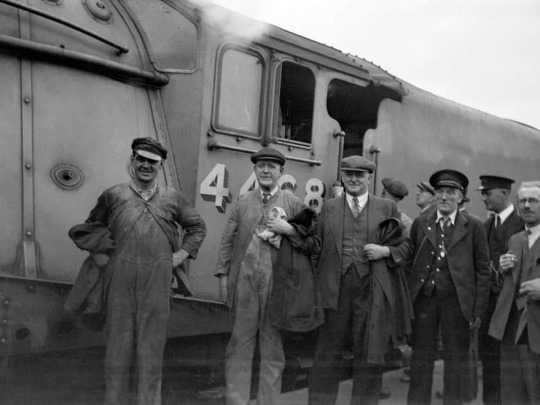
(Image: the crew poses in front of Mallard, a 4-6-2 Pacific locomotive numbered 4468, immediately after setting the speed record. L-R: Tommy Bray [fireman], Joe Duddington [driver/engineer], Inspector Jenkins, Henry Croucher [guard/conductor]. Joe Duddington has turned his hat around to face the correct way again after having it on backwards during the record run. Photo credit: National Railway Museum.)
Joe Duddington actually stayed on a bit past his retirement age to help free up soldiers for the war effort. When he finally retired, on his final day of work, he drove Mallard one last time.
Sir Nigel Gresley himself never accepted the brief stint at 126 mph, instead saying his locomotive set the speed record at 125 mph. But history has accepted the 126 mph as the true top speed, given that Mallard was possibly capable of even more, and today she has plaques on her streamlined cladding to commemorate her feat. A second record attempt was planned to see if she could go even faster, but World War II broke out and the idea was scrapped.
undefined
youtube
Tommy Bray eventually got on the throttle himself, fulfilling his own dreams. Both men are honored in a cemetery in Doncaster with a new memorial headstone for Duddington featuring Mallard on it.
As for Mallard herself, she continued working until April 25th, 1963, at which point she’d clocked nearly a million and a half miles in service. She was pulled for preservation for obvious reasons, and today she lives at the National Railway Museum in York, along with her dynamometer car that recorded her history-setting run. Five of her A4 siblings also survive, and a few of them are operational to this day, including the one named for her designer, Sir Nigel Gresley. Of all of his ‘birds,’ the one that flew fastest was the humble duck.
For more on Mallard and her creator Gresley, here are a few resources:
Mallard: How the Blue Streak Broke the World Speed Record by Don Hale is a great book on the subject that I enjoyed thoroughly. It does have a Kindle edition if you’d prefer an ebook variation, as well, and most major book retailers carry it on their websites.
The National Railway Museum, Mallard’s retirement home, has a 3D experience/ride of sorts that simulates what it was like to be running with her that day, the video of which is online here. Note the music, which mirrors her three cylinders pumping away. The video isn’t able to be embedded, but you can watch it here. There’s also a child-friendly version, too.
Lastly, the appropriately named prog rock band Big Big Train did a song about Mallard called East Coast Racer, which regularly moves me to tears because this locomotive means so much to me and they tell her story so lovingly.
undefined
youtube
I actually recommend checking out the live version, too, because they show the photo of the crew at the end and every single time I start sobbing.
If you want to visit the old girl herself, she’s at the National Railway Museum in York in the UK, and they have a ton of amazing resources and incredible locomotives and rolling stock in their collection. I’d highly recommend checking them out if you can!
Happy Mallard Day, everyone. Fly far, fly fast, make history.
#LNER Mallard#LNER 4468 Mallard#LNER#LNER A4#I like trains#I spent literal hours on this whoops#but she's really important to me
50 notes
·
View notes
Text
The Blanched Soldier
Originally published in 1926; the Americans actually got this one first by a month.
I have covered the Boer War extensively in a previous post, but will add some notes on items directly relevant to this story.
The Imperial Yeomanry were a volunteer i.e. not career military force of mounted infantry formed in 1900 as reinforcements in the Boer War. They were disbanded in 1908 and merged into the Territorial Force, a precursor of what is now called the Army Reserve.
Mounted infantry were infantry that travelled on horseback and fount dismounted. They continued in use into the Cold War, with some units also being "mounted" on bicycles on both sides of the Second World War, before being replaced with mechanised infantry.
Middlesex was the traditional county that covered much of the North and West of what is now Greater London; losing a large chunk of its territory and population to the London County Council in 1889. It was abolished in 1965, but remains very much a thing for sporting and cultural purposes, with its own county cricket team being just one example.
A martinet is a strict disciplinarian, the name coming for a type of short whip. Arnold RImmer from Red Dwarf is sometimes described as such, although the character is clearly meant to be quite pathetic.
The Victoria Cross is the highest British award for gallantry, equivalent to the Medal of Honor and like that medal, frequently awarded posthumously. It also usually requires multiple witnesses to the gallantry in question. It trumps absolutely everything bar the George Cross in the honours system, and it is traditional for a private with a VC to be saluted by a general officer.
The most recent VC was awarded to Joshua Leakey in 2015 for his involvement in a firefight with the Taliban in Afghanistan in 2013, where he took control of a machine gun left on a hill and kept firing even as bullets ricocheted off the weapon.
An elephant gun is a large calibre rifle intended for use against elephants and large animals. They saw some military use in the World Wars by the British against armoured German snipers in the trenches of the First and by the Italians against British armoured cars in North Africa during the Second. Since ivory hunting became taboo, they are much less common.
Bedford is a market town in England and county town of Bedfordshire. It has two stations, the main one being located on the Midland Main Line running into St Pancras. Served by Thameslink, East Midlands Railway and London Northwestern Railway services, the last on the Marston Vale line to Bletchley, it is on the outer edge of the London commuter belt.
The other station at Bedford St. John's is served by LNWR services on the Marston Vale line to Bletchley, which is part of the former Varsity Line from Oxford to Cambridge. The station was resited in 1984.
The Sultan of Turkey - and the whole Ottoman Empire - in 1903 was Abdul Hamid II, a modernising absolute ruler who faced many assassination attempts and was ousted in a coup in 1909, replaced by his half-brother Mehmed V.
The Spectator is a British political magazine that has run since 1828. Being distinctly conservative in its world view, its former editors include one Boris Johnson.
"Squadron" was the traditional term for company or battalion sized cavalry or mounted infantry units. Outside of naval and air force use, it is now used for armoured units, which are frequently old cavalry units that just changed their level of horsepower.
Stoep is an Afrikaans word for "stoop".
Leprosy is transmittable by close contact, but you generally need a lot of it. It is still common in Brazil, much of Africa and India, but is now curable. Prejudice remains a big problem, with "leper colonies" still being common.
The general scholarly consensus is that it wasn't ichthoysis, of which there are many types. The NHS has more information here (with pictures): https://www.nhs.uk/conditions/ichthyosis/
21 notes
·
View notes
Text
Part 8 of shipping different Train Operating Companies Together.
Greater Anglia and East Midlands went on a date once. They had a good time, they didn't have a lot in common, but they shared an interest in the Norfolk Coast. East Midlands was jealous of Greater Anglia as she has seen more of the Norfolk Coast and the coast. Greater Anglia did point out to East Midlands that while he may not visit the coast as much, he gets to enjoy the seaside resort of Skegness while for her, it was much more of doing the jobs along the coastline.
Their first date was a mixed bag, I think they need to find more in common so maybe they will go out again.
4 notes
·
View notes
Text
some things i feel like i should share today as another unelected, money hoarding, tax-dodging, out of touch parasite takes his place as the ‘leader’ of the country:
• i have always been and will always be anti-monarchy. end of.
• today, peaceful protestors on the streets of london are being arrested before they have even started their protests. signs are being confiscated and the public arrested.
• this coronation comes at a time when nurses, junior doctors, teachers and countless others are striking for better working conditions, safety for those they look after and fair pay for the life saving work they do.
• this country has never had more food banks open and overwhelmed. we are drowning in a cost of living crisis that affects everyone but the rich. people have no food and yet east midlands railway is handing out free scones exclusively to it’s first class passengers to celebrate the coronation.
• over 270,000 people in the uk are unhoused (as of jan 2023), living on the streets or in temporary accommodation, meanwhile monarchists have been camping out on the streets for days - uninterrupted by the met police - to catch a fleeting glimpse of a man in a golden carriage driving past.
• speaking of the met police, a recent report found them ‘institutionally racist, misogynistic and homophobic’. just saying.
there’s so much more i could say but i just wanted to illustrate the absolute state of this country at the moment for anyone abroad. we should be ashamed that we as a country are celebrating this day when so many are starving to death, dying on the streets and dying pre/in hospital due to unsafe workplace conditions.
fuck the monarchy. fuck the tories. fuck the police. fuck the coronation. fuck this country and it’s warped sense of what’s right and what’s wrong.
76 notes
·
View notes
Text

#phoneography#mobiele telefoon fotografie#mobile phone photography#smartphoneography#smartphone fotografie#smartphone photography#travel#reizen#reisen#voyage#viajar#travel photography#reisfotografie#EMR#East Midlands Railway#Norwich#train#trein#railway#tren#treno#England#Engeland#Great Britain#Groot Brittannië#United Kingdom#Verenigd Koninkrijk#UK#GB#journey
3 notes
·
View notes
Text

Having recently read a fanfic in which Sherlock and John catch trains to various parts of southern England exclusively from London’s Waterloo station, even when this is not the usual/logical route, I’d like to share this for writers who might not be familiar with the whole business of trains in/to/from London.

Let’s start with the history of how and when rail services came to London. This article explains how and why we have so many terminal stations (short version: because when they were built, the railway companies were privately owned and all needed their own terminus in London).
The main terminal stations are Waterloo (south), Paddington (west), Euston (north-west), King’s Cross (north-east), St Pancras (East Midlands and Eurostar), Liverpool Street (east), Fenchurch Street (south-east) and Victoria (south). There are others (see the article linked above and my husband’s comment below).
As we know, within London and the suburbs, these termini are linked by the London Underground (aka The Tube) network. There is also the Docklands Light Railway (DLR) - a driverless system - and other overground rail services. Here is a map of it all from Transport of London (TfL). Baker Street is served by five tube lines: Bakerloo (brown), Metropolitan (maroon), Jubilee (silver), Circle (yellow), and Hammersmith & City (pink). It’s also only a five-minute walk from Marylebone (the nearest terminal) which itself is just behind the Landmark hotel, which we know as the exterior for The Restaurant Scene.
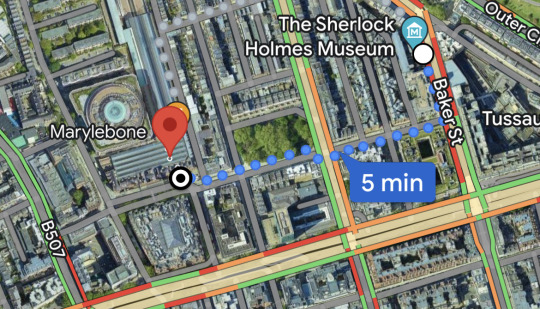
Aside: I think Sherlock is unlikely to catch a bus unless directly related to a case - they’re just too slow for him. But you can find bus maps and all kinds of other TfL mappy delights here.
If you have characters using public transport in the UK, your best bets for accurate research are:
Google Maps (in public transport mode)
National Rail (see the page footer for all the useful stuff)
Transport for London
All these also have apps available.
I’m happy to do Sherlockian Britpicking (my day job is copy-editing) if that’s helpful for you. (Email to [my username]@gmail.com is the best way to reach me.)
If you want to go the full Howard Shilcott, I still very much enjoy reading the rail enthusiasts’ forums posts about the myriad tube-related continuity errors in TEH. I’ll let you Google those for yourself. 😉
———
Ran this past my husband (who is totally the full Howard Shilcott) and he made a few corrections (and a lot of faces!) before I posted: he wishes it to be known that he ‘remains unhappy about [my summary of] Fenchurch Street’ and thinks I should add Charing Cross to the list so people know how to get to Kent. So that’s all clear then. 😂
#London#London travel#London transport#London Underground#London stations#trains#help for fanfic writers#fanfic#trains in England#railways#Railway Britpicking#Britpicking#Britpicker#Why yes I am autistic thank you#Howard Shilcott#info post#infodump#sherlock#British Rail#British trains#English trains#fanfic writing#fanfic Britpick#important details#Sherlock fanfic#Sherlock fanfiction#Sherlock locations
32 notes
·
View notes
Text
East Midlands Railway are emailing me to tell me they have a winter sale on. You’re a key part of the infrastructure of the country with no competitors, why the fuck do you need to have a sale? Tickets should be affordable all the time so people can live and work.
65 notes
·
View notes
Note
hang on. there is actually a station in london called pancreas?? is it on the red line too this is very important information
i'm not a Londoner, nor from the UK, I don't know if it's on the red line. 😭😭 The only thing I know is that it's the terminus for the Eurostar, coming from Paris. @emmalovesfitzloved could help you with this one.
this is what I found on wiki.
"St Pancras railway station (/ˈpæŋkrəs/), officially known since 2007 as London St Pancras International, is a central London railway terminus on Euston Road in the London Borough of Camden. It is the terminus for Eurostar services from Belgium, France and the Netherlands to London. It provides East Midlands Railway services to Leicester, Corby, Derby, Sheffield and Nottingham on the Midland Main Line, Southeastern high-speed trains to Kent via Ebbsfleet International and Ashford International, and Thameslink cross-London service to Bedford, Cambridge, Peterborough, Brighton, Horsham and Gatwick Airport. It stands between the British Library, the Regent's Canal and London King's Cross railway station, with which it shares a London Underground station, King's Cross St Pancras."
7 notes
·
View notes
Text
AIRPORTS TRANSFERS GRANTHAM & TAXI SERVICES.
Grantham Airport Transfers.
Business, Personal, Corporate Airport Taxi Transfers.
If you need reliable and affordable airport transfer to or from Grantham then please call Silver Cabs Grantham Taxis Phone Numbers On: 01476 330492 or Mobile On: 07531 444555
Heathrow Airport Transfers.
HEATHROW AIRPORT TRANSFER PRICES START FROM:£210.00
Book your Taxi Grantham to Heathrow Airport.
Book your Heathrow airport transfer with Silver Cabs Grantham taxis service and we can guarantee safe and stress-free airport run.
Heathrow Airport Information
Airport transfer information provided by Silver Cabs Grantham
Address: Heathrow Airport Limited,
Address: The Compass Centre, Nelson Road, Hounslow, Middlesex, TW6 2GW
Meeting point / pickup point for the meet and greet service.Costa Coffee.
Airport Website: https://www.heathrow.com/at-the-airport/terminal-guides

Heathrow T2 T3 -T4-T5 airport transfer require?
Call our Grantham Taxis Phone Numbers On:01476 330492 Or Mobile On: 07531 444555
Gatwick Airport Transfers.
Taxi Grantham to Gatwick Airport.
Manchester Airport Transfers.
Taxi Grantham to Manchester Airport.
Birmingham Airport Transfers.
Taxi Grantham to Birmingham Airport.
Luton Airport Transfers.
Taxi Grantham to Luton Airport.
Stanstead Airport Transfers.
Taxi Grantham to Stansted Airport.
London City Airport Transfers.
Taxi Grantham to London City Airport.
Airport Taxi Transfers,
Airport Transfers Taxis,
Airport Transfer Services Lincolnshire,East Midlands.


Do you need an airport transfer???
Experience Convenient and Reliable Transportation with Silver Cabs Grantham Taxi Company. Grantham Airport Transfers and Shuttle Services that Exceed Expectations.
Are you tired of the hassle and stress that comes with finding reliable transportation to and from the airport? Look no further than Silver Cabs Grantham Taxi Company. As the leading provider of airport transfers and shuttle services in Grantham and surrounding areas, we are committed to delivering a convenient and reliable transportation experience for our valued customers.
With our extensive fleet of modern and well-maintained vehicles, we ensure that you arrive at the airport on time, every time. Our professional and courteous drivers are highly trained and experienced, guaranteeing a smooth and comfortable journey from start to finish. We take pride in providing a seamless travel experience, allowing you to relax and focus on your upcoming trip.
Heading for a cruise vacation? Let Silver Cabs Grantham Taxis take care of your transportation needs. Our reliable seaport transfer services will ensure that you reach your destination in a timely and hassle-free manner. Whether you're departing from or arriving at the cruise terminals, our professional drivers will be there to assist you every step of the way.
We understand the importance of punctuality when it comes to cruise travel. That's why we strive to provide a seamless connection between your location and the cruise terminals. Our drivers are well-versed in the most efficient routes, ensuring that you never miss your ship or any important embarkation or disembarkation activities. Sit back, relax, and let us take care of all your transportation needs.
Explore the Charming Surrounding Villages and Towns around Grantham,Lincolnshire with Our Local Taxi Services and Rail Station Taxis.Local taxi services and local train station taxis.Grantham train station taxis.Grantham railway station taxi services|Silver Cabs Grantham.
Looking to explore the picturesque villages and towns surrounding Grantham and Lincolnshire? Look no further than Silver Cabs Grantham.
With our knowledgeable drivers at the helm, you can uncover hidden gems and experience the true essence of these charming locations. From Grantham to Sleaford, Bourne to Stamford, Newark to Melton Mowbray, our local rail station taxis will take you on a memorable journey through these enchanting destinations. Discover the rich history, vibrant culture, and breathtaking landscapes that await you.
Experience the Convenience of Grantham Airport Transfers with Silver Cabs.
Reliable Airport Shuttle Services in Grantham and Surrounding Areas.
Seamless Airport and Seaport Transfers with Silver Cabs Grantham Taxis Company.
Smooth and Reliable Cruise Terminal Transfers in Grantham.
Effortless Travel with Silver Cabs Grantham. Explore the Charming Surrounding Villages with Our Local Rail Station Taxis.
Discover Lincolnshire's Hidden Gems with Silver Cabs Grantham Taxi Company.
Convenient Airport and Taxis Transportation Solutions in Lincolnshire,Nottinghamshire,Leicester,Rutland, and Beyond.
Lincolnshire and Leicestershire Best Airport Transfers Services Silver Cabs Grantham Taxi Company
Rutland: Uncover its Beauty with Our Local Rail Station Taxis
East Lindsey Exploration Made Easy with Silver Cabs Grantham Taxi Company
Grantham's Premier Airport Transfer and Shuttle Service Provider
Stress-Free Airport Pick Up and Drop Off with Silver Cabs Grantham Taxi Company
Dependable Airport Transfers in Grantham: Choose Silver Cabs
Grantham Railway Station Taxis - Your Trusted Local Transportation Partner
Discover Grantham and Surrounding Areas with Our Reliable Taxi Services
Your Comfortable and Reliable Transportation Solution in Sleaford
Explore Bourne's Beauty with Silver Cabs Grantham Taxi Company
Stamford Awaits: Experience a Memorable Journey with Our Taxis
Newark's Premier Taxi Services and Airport Transfer Silver Cabs Grantham Taxi Company
Melton Mowbray: Uncover its Rich Heritage with Our Local Rail Station Taxis.
Convenient Transportation Services in Grantham and Beyond
Trusted Airport Shuttle Services in the Lincolnshire Area
Professional and Reliable Taxi Services for Airport Transfers
Your Go-To Taxi Company for Grantham and Surrounding Areas
- Silver Cabs Grantham Taxi Company provides the following services:
- Grantham airport transfers
- airport taxi transfers
- airport shuttle services
- airport pick up
- airport drop off
- airport transfer
- seaport transfer
- cruise terminals transfers
- Grantham railway station taxis
- Grantham train station taxis
- local rail station taxis
- airport shuttle service
- airport taxi cabs
- Lincolnshire
- Nottinghamshire
- Leicestershire
- Rutland
- East Lindsey
- Grantham
- Sleaford
- Bourne
- Stamford
- Newark
- Melton Mowbray
Convenient and Reliable Grantham Airport Taxi Transfers & Taxi Services - Silver Cabs Grantham Taxi Company.
Experience seamless airport transfers and shuttle services in Grantham and surrounding areas with Silver Cabs Grantham Taxi Company. Discover the convenience and reliability you deserve. Book your transportation now!
#airport taxi transfers grantham#Airport Transfers Grantham#Grantham Taxis#Airport Transfers Lincolnshire#Grantham train station taxis#Grantham Railway station taxis#grantham taxi services#airport transfers taxis#airport taxi service#airport shuttle service#taxi service#airport transfer
3 notes
·
View notes
Photo

The new Æthelflaed statue outside Tamworth Railway Station, erected to commemorate 1,100 years since her death in Tamworth. Her spear points visitors towards the town centre and Tamworth Castle.
Æthelflæd, Lady of the Mercians (c. 870 – 12 June 918) ruled Mercia in the English Midlands from 911 until her death. She was the eldest daughter of Alfred the Great, king of the Anglo-Saxon kingdom of Wessex, and his wife Ealhswith.
Æthelflæd was born around 870 at the height of the Viking invasions of England. By 878, most of England was under Danish Viking rule – East Anglia and Northumbria having been conquered, and Mercia partitioned between the English and the Vikings – but in that year Alfred won a crucial victory at the Battle of Edington. Soon afterwards the English-controlled western half of Mercia came under the rule of Æthelred, Lord of the Mercians, who accepted Alfred's overlordship. Alfred adopted the title King of the Anglo-Saxons (previously he was titled King of the West Saxons like his predecessors) claiming to rule all Anglo-Saxon people not living in areas under Viking control. In the mid-880s, Alfred sealed the strategic alliance between the surviving English kingdoms by marrying Æthelflæd to Æthelred.
Æthelred played a major role in fighting off renewed Viking attacks in the 890s, together with Æthelflæd's brother, the future King Edward the Elder. Æthelred and Æthelflæd fortified Worcester, gave generous donations to Mercian churches and built a new minster in Gloucester. Æthelred's health probably declined early in the next decade, after which it is likely that Æthelflæd was mainly responsible for the government of Mercia. Edward had succeeded as King of the Anglo-Saxons in 899, and in 909 he sent a West Saxon and Mercian force to raid the northern Danelaw. They returned with the remains of the royal Northumbrian saint Oswald, which were translated to the new Gloucester minster. Æthelred died in 911 and Æthelflæd then ruled Mercia as Lady of the Mercians. The accession of a female ruler in Mercia is described by the historian Ian Walker as "one of the most unique events in early medieval history".
Alfred had built a network of fortified burhs and in the 910s Edward and Æthelflæd embarked on a programme of extending them. Among the towns where she built defences were Wednesbury, Bridgnorth, Tamworth, Stafford, Warwick, Chirbury and Runcorn. In 917 she sent an army to capture Derby, the first of the Five Boroughs of the Danelaw to fall to the English, a victory described by Tim Clarkson as "her greatest triumph". In 918 Leicester surrendered without a fight. Shortly afterwards the Viking leaders of York offered her their loyalty, but she died on 12 June 918 before she could take advantage of the offer, and a few months later Edward completed the conquest of Mercia. Æthelflæd was succeeded by her daughter Ælfwynn, but in December Edward took personal control of Mercia and carried Ælfwynn off to Wessex.
Historians disagree whether Mercia was an independent kingdom under Æthelred and Æthelflæd but they agree that Æthelflæd was a great ruler who played an important part in the conquest of the Danelaw. She was praised by Anglo-Norman chroniclers such as William of Malmesbury, who described her as "a powerful accession to [Edward's] party, the delight of his subjects, the dread of his enemies, a woman of enlarged soul". According to Pauline Stafford, "like ... Elizabeth I she became a wonder to later ages". In Nick Higham's view, medieval and modern writers have been so captivated by her that Edward's reputation has suffered unfairly in comparison.
83 notes
·
View notes